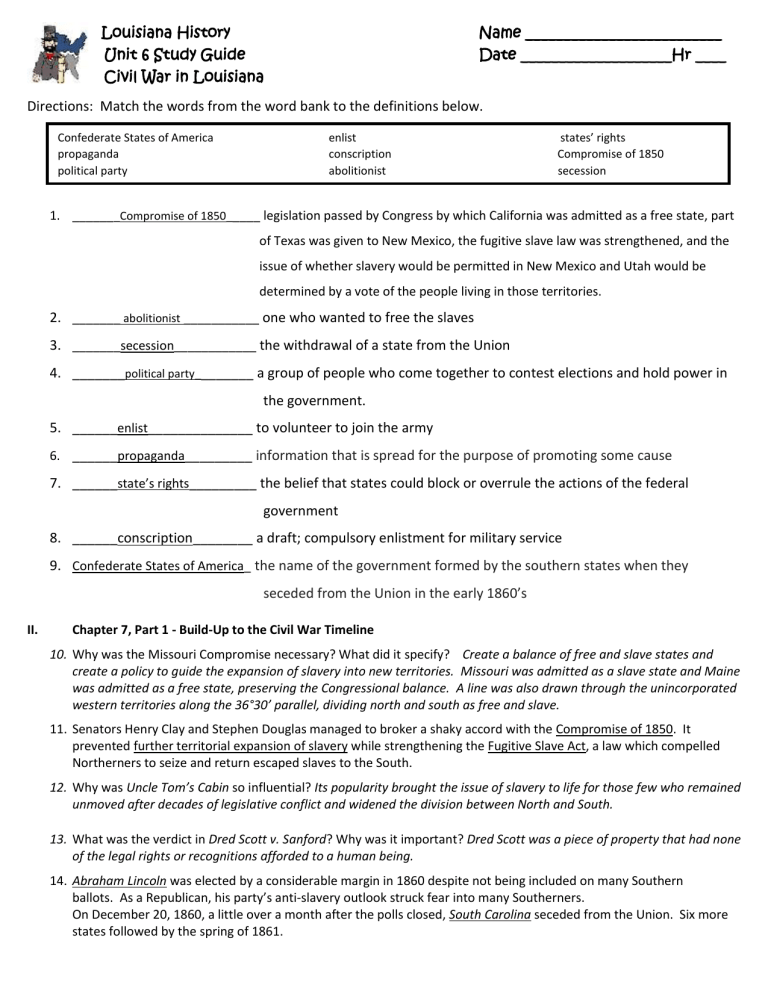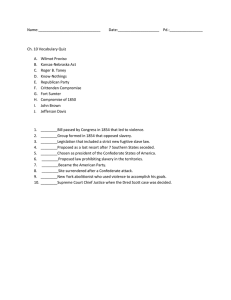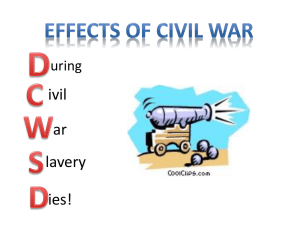
Louisiana History Unit 6 Study Guide Civil War in Louisiana Name __________________________ Date ____________________Hr ____ Directions: Match the words from the word bank to the definitions below. Confederate States of America propaganda political party enlist conscription abolitionist states’ rights Compromise of 1850 secession 1. _______Compromise of 1850_____ legislation passed by Congress by which California was admitted as a free state, part of Texas was given to New Mexico, the fugitive slave law was strengthened, and the issue of whether slavery would be permitted in New Mexico and Utah would be determined by a vote of the people living in those territories. 2. _______ abolitionist ___________ one who wanted to free the slaves 3. _______secession____________ the withdrawal of a state from the Union 4. _______political party________ a group of people who come together to contest elections and hold power in the government. 5. ______enlist______________ to volunteer to join the army 6. ______propaganda_________ information that is spread for the purpose of promoting some cause 7. ______state’s rights_________ the belief that states could block or overrule the actions of the federal government 8. ______conscription________ a draft; compulsory enlistment for military service 9. Confederate States of America_ the name of the government formed by the southern states when they seceded from the Union in the early 1860’s II. Chapter 7, Part 1 - Build-Up to the Civil War Timeline 10. Why was the Missouri Compromise necessary? What did it specify? Create a balance of free and slave states and create a policy to guide the expansion of slavery into new territories. Missouri was admitted as a slave state and Maine was admitted as a free state, preserving the Congressional balance. A line was also drawn through the unincorporated western territories along the 36°30’ parallel, dividing north and south as free and slave. 11. Senators Henry Clay and Stephen Douglas managed to broker a shaky accord with the Compromise of 1850. It prevented further territorial expansion of slavery while strengthening the Fugitive Slave Act, a law which compelled Northerners to seize and return escaped slaves to the South. 12. Why was Uncle Tom’s Cabin so influential? Its popularity brought the issue of slavery to life for those few who remained unmoved after decades of legislative conflict and widened the division between North and South. 13. What was the verdict in Dred Scott v. Sanford? Why was it important? Dred Scott was a piece of property that had none of the legal rights or recognitions afforded to a human being. 14. Abraham Lincoln was elected by a considerable margin in 1860 despite not being included on many Southern ballots. As a Republican, his party’s anti-slavery outlook struck fear into many Southerners. On December 20, 1860, a little over a month after the polls closed, South Carolina seceded from the Union. Six more states followed by the spring of 1861. III. Chapter 7, part 2 – African Americans and Women 15. Who were the Louisiana Native Guard? Explain the perceptions of African-Americans in the military. The Louisiana Native Guard was a unit composed of free men of color, loyal to the Confederacy. In 1861, they drilled next to Confederate soldiers, but they were not formally part of their army. Neither the North nor the South embraced the idea that African Americans should serve in their respective militaries in any capacity except that of laborer. 16. How did the Anaconda Plan affect daily life in the South during the Civil War? The Anaconda Plan was successful, and Southerners experienced food and supply shortages for almost the entirety of the war. 17. What did women back in Louisiana do while their husbands were at war? women were managing the plantations, Some women followed their husbands to army camps, where they cooked, cleaned, and mended uniforms. Some of those women acted as nurses. Women who stayed formed relief societies, collecting food, money, and supplies. Some found work in factories making war materials. IV. Chapter 7, Part 3 - The War 18. Explain the Anaconda Plan. What were the goals? Why were those the goals? blockade Southern ports and transportation avenues, ultimately depriving them of food, clothing, and other supplies. It would also prevent them from shipping supplies out, hurting their economy. This plan would allow full access to the Mississippi River enabling the North to launch a land invasion to the rest of the Southern states. 19. Why was capturing New Orleans important to the Union? New Orleans was, and still is today, the biggest port in the South. Control of the city would put a severe dent in the Confederate economy. The city itself was the South’s leading producer of manufactured goods and naval ships. 20. What did the people of New Orleans do when they heard the Union was coming? Burn supplies to keep them from Union hands 21. On April 26, 1862, Admiral Farragut hoisted the United States flag over the New Orleans Mint. On May 1, he handed the city over to the appointed military governor, Union General Benjamin Butler. In December, the Union would seize Baton Rouge. 22. Why were the battles in Vicksburg and Port Hudson so important? Cemented Union control of the Mississippi River 23. The Red River Campaign was the Union attempt to capture Shreveport, the Confederate capital of Louisiana, in early 1864. The campaign’s decisive battle was the Battle of Mansfield, a Confederate victory. However, it did little for Confederate morale after their loss of Vicksburg and failure in Gettysburg, Pennsylvania. Shreveport would be the last Confederate capital to surrender, two months after the war formally ended in Appomattox, Virginia. 24. On April 9, 1865, Confederate General-in-Chief Robert E. Lee surrendered to Union Commander Ulysses. S. Grant, ending the Civil War. More than 500 battles had been fought in Louisiana. The Union victory meant an end to slavery, and an end to the plantation economic system. V. Battles in Louisiana 25. Describe two ways physical features of Louisiana played a role in the location of battles fought in Louisiana during the Civil War? the rivers and waterways impacted the location of the Civil war battles and the use of Union war boats and navy in battles against confederate Louisiana.


